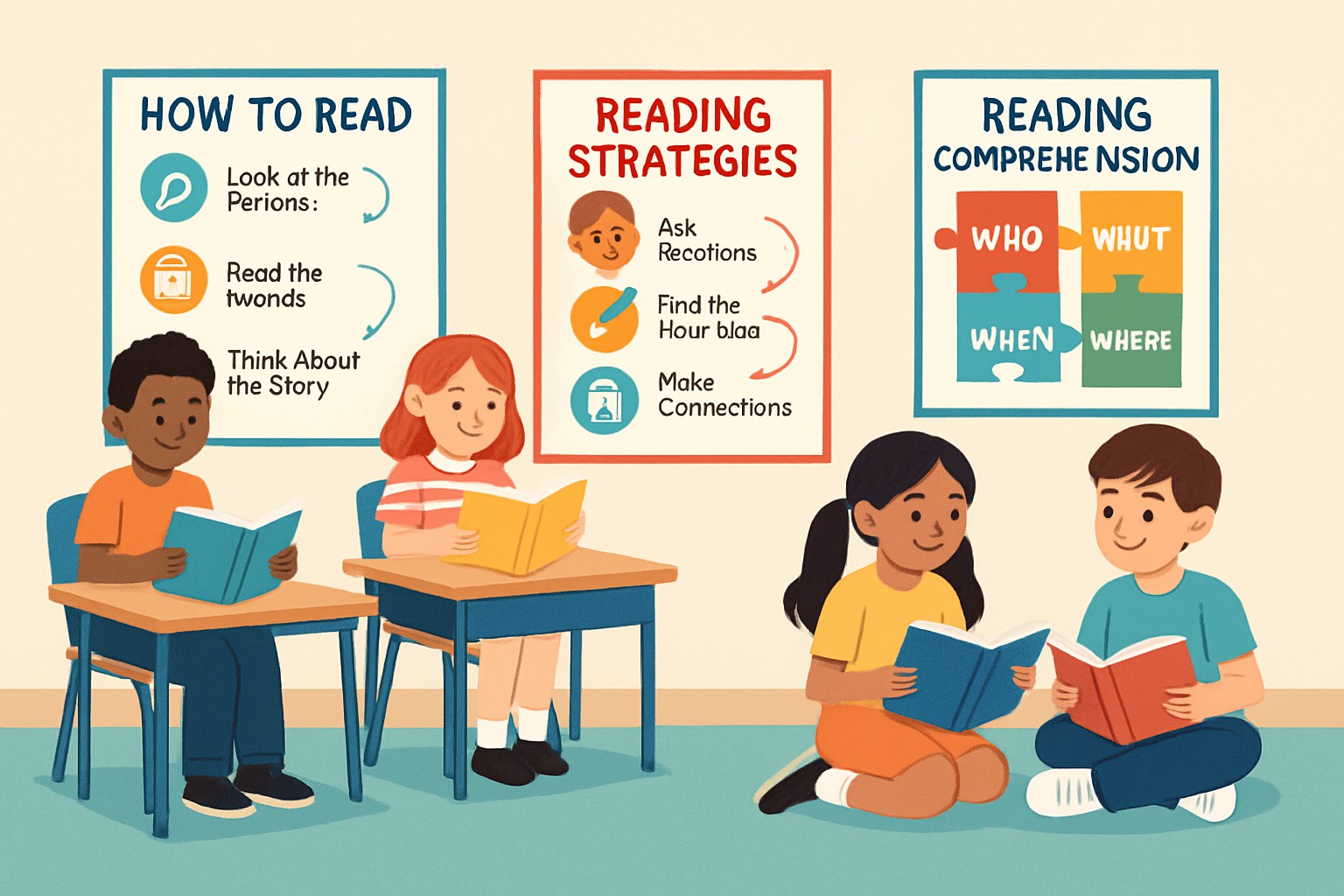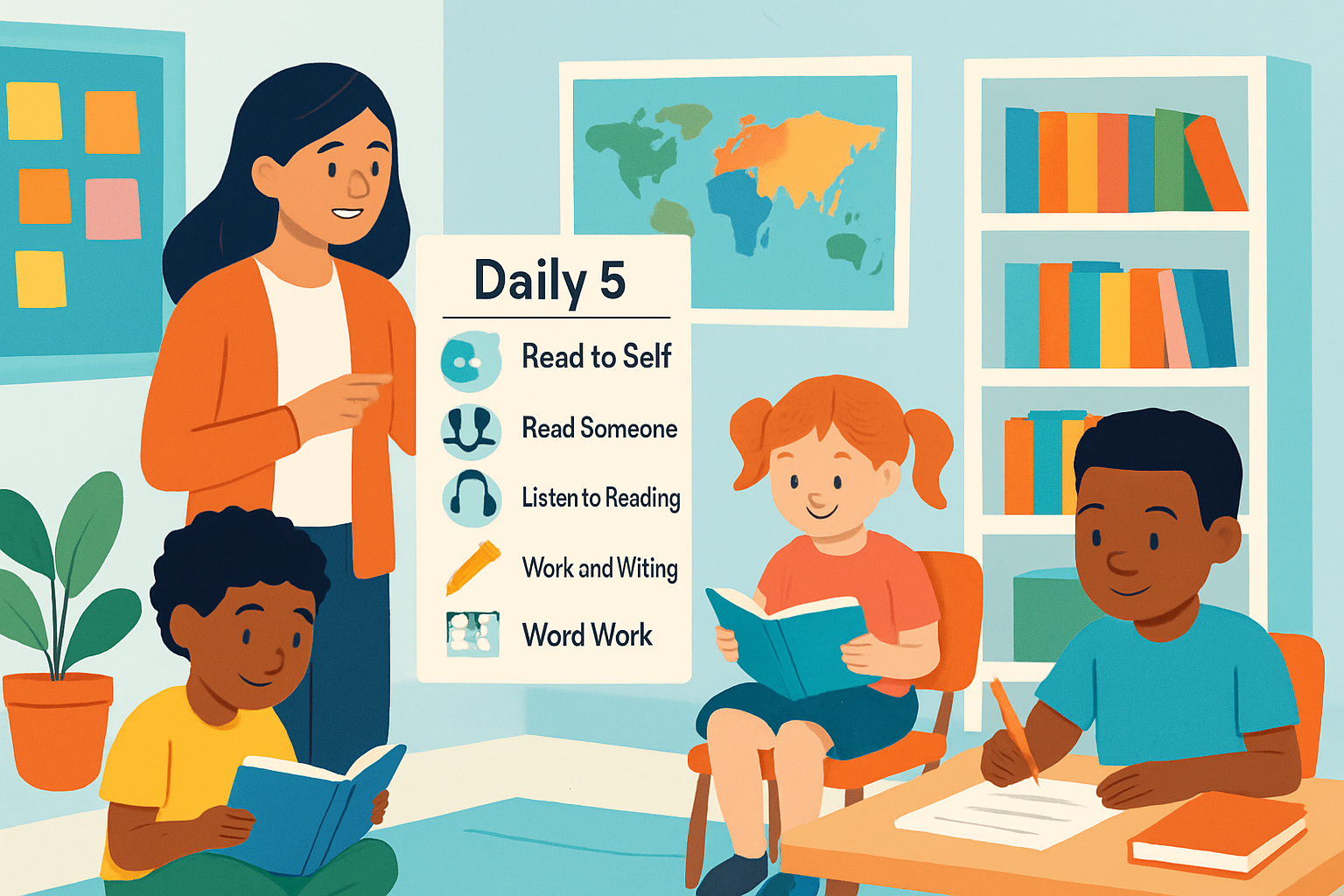Daily 5 Resources To Help Students Build Reading Habits

The Daily 5 framework is a tried-and-true method that nudges students to develop steady reading habits through well-organized activities, making quality daily 5 resources essential for implementation.
Nurturing a daily reading habit from an early age really sets the stage for strong literacy skills that stick with you.
Taking a Closer Peek at the Daily 5 Framework
The Daily 5 consists of five core literacy activities designed to nurture solid reading habits and skills: Read to Self, Read to Someone, Listen to Reading, Work on Writing and Word Work.
- Read to Self gently nudges students to dive into books solo, helping them build focus and reading stamina one page at a time.
- Read to Someone encourages teamwork and fluency by sparking lively chats about texts with peers because a little back-and-forth can work wonders.
- Listen to Reading supports understanding by offering audiobooks or read-aloud sessions that quietly tune up those auditory skills.
- Work on Writing strengthens reading muscles by getting students to put pen to paper through journaling and creative tasks that actually feel fun.
- Word Work pumps up vocabulary and spelling with hands-on, interactive activities that keep students engaged without feeling like a chore.
These components team up to strike a well-balanced approach that nudges student independence just enough while keeping learners genuinely engaged in their journey through literacy. The framework champions autonomy but with a friendly hand and offers ways to help readers build a richer and more meaningful connection to what they’re reading.
Five Fantastic Daily Resources That'll Actually Help You Build Reading Habits
Teachers are lucky to have a treasure trove of resources at their fingertips that really help make Daily 5 a breeze to implement. These handy tools lend a hand with everything from lesson planning and keeping an eye on progress to boosting student engagement.
Printable lesson plans and templates that provide a clear structure and handy guidance—think of them as your trusty roadmap through the teaching day.
Reading logs and progress trackers crafted to cheer on students while keeping a solid handle on their reading habits.
Anchor charts and visual aids that really help to lock in those tricky reading strategies—because sometimes a picture is worth a thousand words.
Guided reading materials paired with book recommendations thoughtfully matched to different skill levels, making sure no one feels left behind.
Digital apps and tools designed to boost Daily 5 activities with engaging, interactive features that bring a little extra sparkle to the routine.
1. Lesson Plans and Templates You Can Actually Print Out
Ready-made lesson plans take a lot off teachers’ plates by helping Daily 5 reading sessions run like clockwork, saving precious prep time while making sure all the key points are covered.
- Clear goals that tie each activity directly to literacy outcomes, so nothing feels random or out of place.
- A detailed breakdown of every activity, with suggested timing to keep things running smoothly without feeling rushed or dragging on.
- Handy tips on tracking student progress and tweaking your teaching approach when necessary, because flexibility is key.
2. Keeping Track of Reading Logs and Progress
Keeping tabs on your reading logs and progress might sound straightforward, but it can really make a world of difference. I have found that jotting down notes as you go or marking milestones not only boosts motivation but also adds a nice sense of accomplishment. It’s like having your own little scoreboard, quietly cheering you on as you turn each page. Plus, watching your progress unfold is oddly satisfying and helps keep that reading habit firmly in place.
Reading logs encourage students to take the reins of their reading journey by jotting down titles and times along with their own reflections. These handy tools give teachers a clear window into independent reading habits and progress.
- Features layouts that are friendly and straightforward, making it a breeze for students to keep up with their writing habit.
- Offers cozy little nooks for personal reflections, helping students really chew over what they have learned.
- Includes handy visual graphs and charts that paint a clear picture of reading progress and accomplishments, so keeping track never feels like a chore.
3. Anchor Charts and Visual Supports your trusty sidekicks in the classroom
Anchor charts serve as handy visual reminders for Daily 5 routines and reading strategies, gently nudging students to recall important concepts and steps.
Effective anchor charts are clear and colorful and hung right where students cannot miss them. Throwing in some icons or examples usually does the trick and helps all kinds of learners connect with the material.
4. Guided Reading Materials and Book Suggestions
Sometimes finding the right book or guided reading material feels like hunting for a needle in a haystack. Let’s make that search a bit less daunting by diving into curated selections designed to captivate and educate. Whether you are looking for a cozy read or something that really stretches the mind, this section has got you covered with suggestions that won’t disappoint.
Guided reading materials feature leveled books and lesson supports crafted to fit a wide spectrum of student needs. The carefully picked book lists align with the Daily 5 approach and help students dive into texts that are just right for their level and genuinely engaging.
- Picking books that truly match students' reading levels can really set them up for success and growth—no guesswork needed.
- Throwing in topics that spark students’ interests usually makes Read to Self and Read to Someone time way more engaging and lively.
- Choosing texts that line up with Daily 5 goals helps keep skill-building on point during each activity, making practice feel less like a chore and more like progress.
5. Digital Tools and Apps
Sometimes, the right digital tools and apps can feel like a trusty sidekick—ready to jump in and save the day when you least expect it. Whether you’re a tech newbie or a seasoned pro, there’s probably something out there that can make your life a little easier, or at least less chaotic.
Technology plays a handy role in the Daily 5 routine by offering eBooks and interactive comprehension activities as well as audio options for Listen to Reading. These digital tools keep students hooked and give teachers a straightforward way to track progress.
- EBook libraries offer a treasure trove of titles that you can dive into anytime and from just about anywhere—no dusty shelves required.
- Apps with interactive prompts often do a nifty job of boosting comprehension and helping build vocabulary skills along the way.
- Listening centers with recorded stories are a real boon for those who soak up information better by listening rather than reading.
- Digital tracking tools make it surprisingly easy to keep tabs on reading time and watch progress unfold—kind of like having a personal coach in your pocket.
Tips for Successfully Using Daily 5 Resources in Your Classroom
Getting the hang of Daily 5 can feel like learning to ride a bike—wobbly at first but smooth sailing once you’re pedal-perfect. These tips will help you make the most of the resources without any head-scratching moments. Think of it as your friendly nudge toward classroom magic, blending structure with just the right dash of flexibility.
To make the most of Daily 5 resources teachers have to roll up their sleeves and get all the materials lined up. They must clearly spell out the routines, walk through each activity step-by-step, and keep the practice steady as a rock.
Kick things off by gathering all the materials you will need—think lesson plans and anchor charts plus reading resources.
Clearly teach the Daily 5 routines and explain why each activity matters and what you expect from your students. This helps set the tone.
Show each task a few times and patiently repeat until your students give you the green light that they’re with you.
Set up a consistent schedule with fixed times for the Daily 5 rotations because routine is key.
Keep a watchful eye on students as they work independently and jump in with support or positive feedback whenever you spot an opportunity to boost confidence.
Regularly carve out time to reflect on how things are going. Adjust the resources or routines as needed to keep pace with your students’ evolving needs. It’s a bit like tuning an instrument, really.
Teachers often find themselves wrestling with noise levels and trying to keep students glued to their tasks during independent work—it's no small feat. The trick usually lies in laying down clear behavior expectations upfront and cleverly employing timers. Switching up activities helps keep the daily routine from feeling like a stale rerun.
Measuring Student Reading Habits and Success
Evaluating how Daily 5 resources influence reading habits calls for a mix of both formal and informal approaches. Keeping a close eye on student progress not only helps steer teaching in the right direction but also ensures reading development doesn’t veer off course.
- Student self-assessments encourage a bit of honest reflection on their reading stamina and just how hooked they feel on the material.
- Teacher observations provide those golden nuggets of insight into how students really engage with texts and put their skills into action.
- Keeping an eye on reading fluency uncovers shifts in both speed and accuracy as time goes by.
- Progress logs make it a breeze to track how reading habits have evolved over the long haul.
When teachers roll up their sleeves and dig into collected data, they can fine-tune their daily 5 resources and tweak instruction to genuinely support each student in building strong lasting reading habits.






